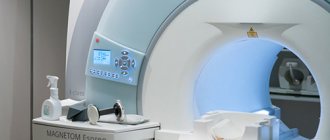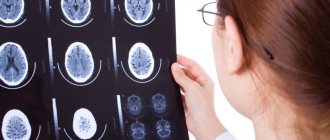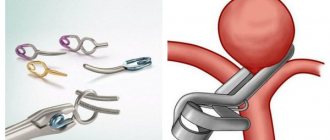How does a brain abscess develop?
There are several options for the development of a brain abscess:
- hematogenous (inflammatory processes in the lungs, gastrointestinal infections and sepsis);
- through infection as a result of traumatic brain injury;
- purulent-inflammatory (caused by inflammation in the nose and ears);
- infected (complications after neurosurgical interventions).
After infection penetrates, an abscess forms within three weeks and has the following stages:
- The first three days: the development of encephalitis (local tissue inflammation), which can be eliminated with antibacterial therapy.
- Days 4-9: inflammation progresses, the cavity filled with pus increases.
- 10-13 days: the formation of a protective capsule around the purulent focus, this prevents the process from spreading.
- Third week: compaction of the capsule with pus. Depending on the treatment taken at this stage, the brain abscess may begin to develop in the opposite direction or increase in size, and new foci of inflammation may also begin to appear.
Symptoms of a brain abscess
The difficulty of independently detecting a brain abscess is that it does not have unique symptoms, but only those that can be attributed to any other inflammatory diseases or brain diseases:
- general malaise;
- weakness;
- chills;
- vomit;
- apathy;
- headache;
- eye irritation from light;
- increased intracranial pressure;
- mental disorders, nervousness.
Therefore, if the above symptoms appear, you should consult a doctor as soon as possible. When a specialist diagnoses an abscess, the main reason for a more accurate examination will be the presence of an inflammatory process, which is accompanied by the appearance of neuropsychiatric disorders. To diagnose a brain abscess, the following are used:
- CT scan;
- MRI of the brain;
- MS spectroscopy;
- Ophthalmoscopy (detection of signs of intracranial pressure);
- Blood test (detecting signs of inflammation).
As a result of the diagnosis, the stage of the brain abscess will be determined and treatment will be selected.
Acute neuroinfections and their consequences
Acute neuroinfections and their consequences.
Infectious lesions of the nervous system are one of the most common forms of neurological pathology, which accounts for at least 42% of all diseases in this area.
Neuroinfection of the brain is classified depending on the localization of the pathological process, based on which they distinguish:
encephalitis
(inflammation of brain tissue caused by infection);
myelitis
(inflammatory process of the spinal cord caused by pathogens);
arachnoiditis
(infectious inflammation affects the arachnoid mater);
meningitis
(infectious inflammation spreads to the membranes of the brain).
In addition to the listed types of neuroinfection, combined pathologies also develop, for example, encephalomyelitis, meningoencephalitis.
Combined forms of infection of the nervous system are much more difficult to diagnose, even though in recent years the ability to diagnose neuroinfections has improved significantly.
Depending on the duration of the pathogenic process, acute (meningitis, encephalitis), subacute and chronic (arachnoiditis, arachnoencephalitis) course of infection of the central nervous system is distinguished.
The main route of transmission is airborne droplets: infection most often occurs through contact with a virus carrier, a sick person, during coughing or sneezing. The infection is transmitted, including through a kiss, if saliva gets on the mucous membrane of healthy people.
A predisposing factor is the presence of erosions on the gums or their inflammation, as well as microscopic injuries to the mucous epithelium of the oral cavity - if the above circumstances are relevant, it will be easier for the pathogen to penetrate the body and begin to circulate in it, developing an infection.
The hematogenous route of infection is no less common. The pathological process spreads to the brain and spinal cord when there is a focus of chronic infection in the body, including damage to the vessels supplying these important centers. Such predisposing pathologies are otitis media, brain abscess, and thrombosis of the cerebral sinuses.
Neuroinfection develops, among other things, due to the lymphogenous transmission route, when hidden complications of traumatic brain and spinal cord injuries are present in the patient’s body. Especially if it is aggravated by liquorrhea.
The infection is not transmitted through household contact, therefore, if you use the personal means and belongings of a virus carrier, infection will not occur. The seasonality of the pathology - hot summer - this condition is the most favorable for the spread of infection, therefore populated areas with a dry, hot climate are more susceptible to neuroinfection.
In general, it should be noted that an infection that affects the nervous system can be caused by both viral, bacterial and fungal etiologies.
Voicing the diagnosis, taking into account the origin of the pathogen, the penetration of which into the body gave rise to the infection. Therefore, they specify “bacterial”, “viral”, “fungal” (meningitis, encephalitis, etc.)
The causes of neuroinfection of the brain are:
Previous traumatic brain injuries
(especially those accompanied by prolonged compression);
hypothermia
(staying in low temperature air without a hat);
if during surgical interventions on the brain or spinal cord, medical instruments or consumables were used of poor quality sterilization
;
if the surgical or therapeutic intervention was complicated by a violation of the integrity of the doctor’s gloves
or was carried out without their use;
past viral diseases
(usually influenza).
Neuroinfection often occurs as a hospital-acquired disease and can result from a visit to a dentist who used insufficiently disinfected instruments during work. Predisposing factors include:
low immunity
(especially if the patient has HIV, tuberculosis, syphilis or other diseases that undermine the body’s protective properties);
the presence of foci of purulent infection
(tonsillitis, otitis), their latent course or rapid transition from the acute stage to the chronic form;
ignoring follow-up examinations after illnesses
, as well as traumatic or spinal injuries.
In neurological practice, the following types of infections of the nervous system are encountered.
Meningitis is an inflammation of the membranes of the brain and/or spinal cord. Infection occurs by hematogenous, lymphogenous or airborne route.
Pathogenic agents – viruses, bacteria, fungi; predisposing factors are the presence (including hidden) of purulent or inflammatory chronic processes in the sinuses of the nasopharynx or auditory canal, as well as hypothermia of the body.
The symptoms of meningitis are quite specific: by visualizing them, you can quickly diagnose this type of neuroinfection and begin its treatment.
The most pronounced manifestations:
stiff neck muscles
(the patient cannot tilt his head forward);
intense headache , which is always accompanied by vomiting
(this symptom raises doubt among experts as to whether the patient has meningitis or a concussion - the determining factor is the medical history);
increase in body temperature to a high level
.
Treatment involves bed rest and antibiotic therapy with broad-spectrum antimicrobial drugs. The prognosis is favorable.
Arachnoiditis is an inflammatory process localized in the arachnoid membrane of the brain. The development of arachnoiditis is caused by head injuries, the presence of rheumatism, and an untreated ENT infection in a timely manner.
Symptoms of this type of neuroinfection are:
severe, persistent headache, making it impossible to perform even basic actions; blurred vision; weakness; nausea, the attack of which ends with vomiting; increased body temperature; possible development of nosebleeds due to cerebral circulation disorders; insomnia; in severe cases - impaired consciousness or its absence.
The prognosis for the patient is favorable only if the diagnosis is made in a timely manner and treatment is carried out. Therapy for this disease is aimed at eliminating the inflammatory process, stabilizing cerebral circulation and generally strengthening the patient’s body.
Encephalitis - inflammation of brain tissue is a consequence of tick-borne infection, as well as the penetration and exposure of bacteria and viruses. If the patient neglects to seek medical help, the prognosis is unfavorable and even fatal. The symptoms of this type of neuroinfection are pronounced:
headache worsens when lying down, is persistent (poorly and briefly relieved by analgesics); there is an increase in body temperature; weakness and a feeling of exhaustion increase, as manifestations of general intoxication of the body.
Lasomotor disorders are part of the symptom complex characteristic of this type of neuroinfection: the patient develops ptosis (drooping of the eyelid), a feeling of double vision, and general blurred vision.
Dyspepsia is manifested by nausea, which especially often occurs after traveling by transport; vomiting occurs.
Hospitalization involves further therapy with antibiotics, hormonal drugs and restoratives.
The most informative type of research is MRI, CT, and encephalogram. The laboratory part of the diagnosis involves testing blood and urine.
An analysis of the cerebrospinal fluid (CSF) is also carried out, in which an increased level of protein is determined. Each of these diagnostic procedures allows you to visualize the state of the brain and spinal cord, determine the localization of the pathogenic process, the degree of infection and involvement of tissues in the inflammatory process.
Treatment of neuroinfection is as follows:
Having established a diagnosis, the patient is hospitalized. Vein catheterization is performed
(a permanent intravenous catheter is installed).
Antibiotic therapy is prescribed
.
The antimicrobial drug is selected by the doctor taking into account which pathogen provoked the development of the neuroinfection: only by adhering to this can one count on the success of the treatment. Antibiotics are administered intravenously or drip (via infusion), since this ensures that the drug immediately enters the bloodstream, as opposed to intramuscular injections. Commonly used drugs include Cefepime, Medaxone, and Ceftazidime. The patient is prescribed hormonal drugs
- mainly Prednisolone and Dexamethasone, the dosage of which is determined by the severity of the patient and the form of the pathology.
If the neuroinfection is combined, then the dosage of the hormonal substance should be higher than for a separate infectious disease of the nervous system. The patient's immunity is supported
by the introduction of vitamin complexes.
Correction of blood pressure levels
is carried out by administering magnesium sulfate.
In order to reduce the degree of cerebral edema
, the patient is administered diuretics: Furosemide, Lasix.
Throughout the patient's stay in the hospital, the vital signs of his body are monitored
.
Maintaining them at a normal level is ensured by constant infusion therapy of the patient with saline solutions and glucose. Monitor diuresis
.
In order to prevent exhaustion, the patient is given parenteral nutrition
; carry out hygienic care. The most severe consequences of neuroinfection include death; disability; dementia. These consequences are a good reason not to delay seeking medical help, undergo an examination and follow all doctor’s prescriptions. It is possible to prevent the development of neuroinfection: to do this, you should promptly treat ENT and dental pathologies, avoid contact with infected people, wear a hat at low air temperatures and strengthen immunity. Neuroinfections - what is it? What are the causes of the development of such diseases, effective ways of treatment? Such questions are faced by people who first heard from a doctor that they are developing a neuroinfection. In medical reference books, this disease is interpreted as infectious, caused by fungi, viruses or bacteria, which affects the nervous system, and has a severe course with a high mortality rate. Neuroinfection includes a fairly large list of diseases, many of which are destructive to the brain. All of them can have an acute form of the course or become chronic and proceed rather sluggishly. As medical practice shows, these diseases can pass in an acute form once and no longer bother the patient or have frequent and vivid relapses until the end of his days. Among all the diseases in this group, acute forms include:
Encephalitis - inflammation of the brain matter. The most common cause is tick-borne encephalitis virus. Meningitis - inflammation of the lining of the brain. Both the brain and the spinal cord can be affected here. Tetanus. Rabies. Myelitis - the spinal cord becomes inflamed due to an infection running in it. Arachnoiditis - the arachnoid membrane of the brain becomes inflamed.
Chronic forms include:
neurosyphilis; neuroAIDS; leprosy; damage to the nervous system by tuberculosis; neurobrucellosis; brucellosis.
Regardless of the type and location of the lesion, neuroinfection of the brain and spinal cord manifests itself in three striking symptoms:
General intoxication of the body. The patient's body temperature rises sharply, very often to critical levels, general weakness appears in the body, and the ability to work decreases. Liquor syndrome. In the cells of the cerebrospinal fluid, the amount of protein and cells that prevail over proteins increases significantly. Symptoms of liquor hypertension. Patients indicate that in a lying position their headache increases significantly, especially in the morning, confusion or absent-mindedness may occur, and there are cases of tachycardia and low blood pressure.
Myelitis. This type of neuroinfection is considered one of the most severe and dangerous for humans. When the spinal cord is damaged, serious complications almost always remain: nerve cells die, which leads to paralysis, dysfunction of the intestines, and bladder. Treatment will include drugs from the group of glucocorticosteroids and broad-spectrum antibiotics. It is very important to undergo timely treatment in a hospital in order to immediately stop the development of concomitant diseases that will be activated against the background of myelitis. Since in almost all cases paralysis occurs with myelitis, it is extremely important to organize proper care for the patient and his skin, to use products that prevent the appearance of bedsores.
After illnesses, an adult is left with a headache and constant pain in the back, which intensifies when the weather changes. Many doctors also note that after recovery in such patients, memory deteriorates, problems with memorization are noted, and hearing and vision may be impaired. There are isolated cases when a neuroinfectious disease leads to complete disability, a person loses sight or hearing.
However, to clarify the diagnosis and determine the location of the lesion, laboratory and instrumental methods are used:
Neuroimaging methods: computer and magnetic resonance imaging, allow you to assess the condition of the tissue of the central nervous system and meninges. Electroencephalography is used to assess the functioning of brain cells and can reveal the extent and severity of damage to nerve tissue. Electroneuromyography is used to determine the severity of damage to the nerve pathways if the patient has paresis or paralysis. Lumbar puncture followed by analysis of cerebrospinal fluid allows us to identify the inflammatory process in the central nervous system and determine its causative agents (viruses or bacteria). Clinical and biochemical blood tests help identify the inflammatory process in the body. Correct use of the described methods, together with the collection of complaints and a neurological examination, allows you to make the correct diagnosis and prescribe rational treatment.
« Back to previous page
Treatment of brain abscess
When treating a brain abscess, two types of treatment can be used together or separately:
- Drug treatment involves the use of antibacterial and anti-inflammatory drugs.
- Surgical treatment - in the last stages of abscess development, the lesion is cut, removing purulent formations and treating the cavity with an antibiotic.
- Detoxification of the body to eliminate the effects of an abscess and prevent its development again.
- General restorative therapy that provides the patient with a full recovery.
- Elimination of functional disorders that appear as a result of severe disease.









